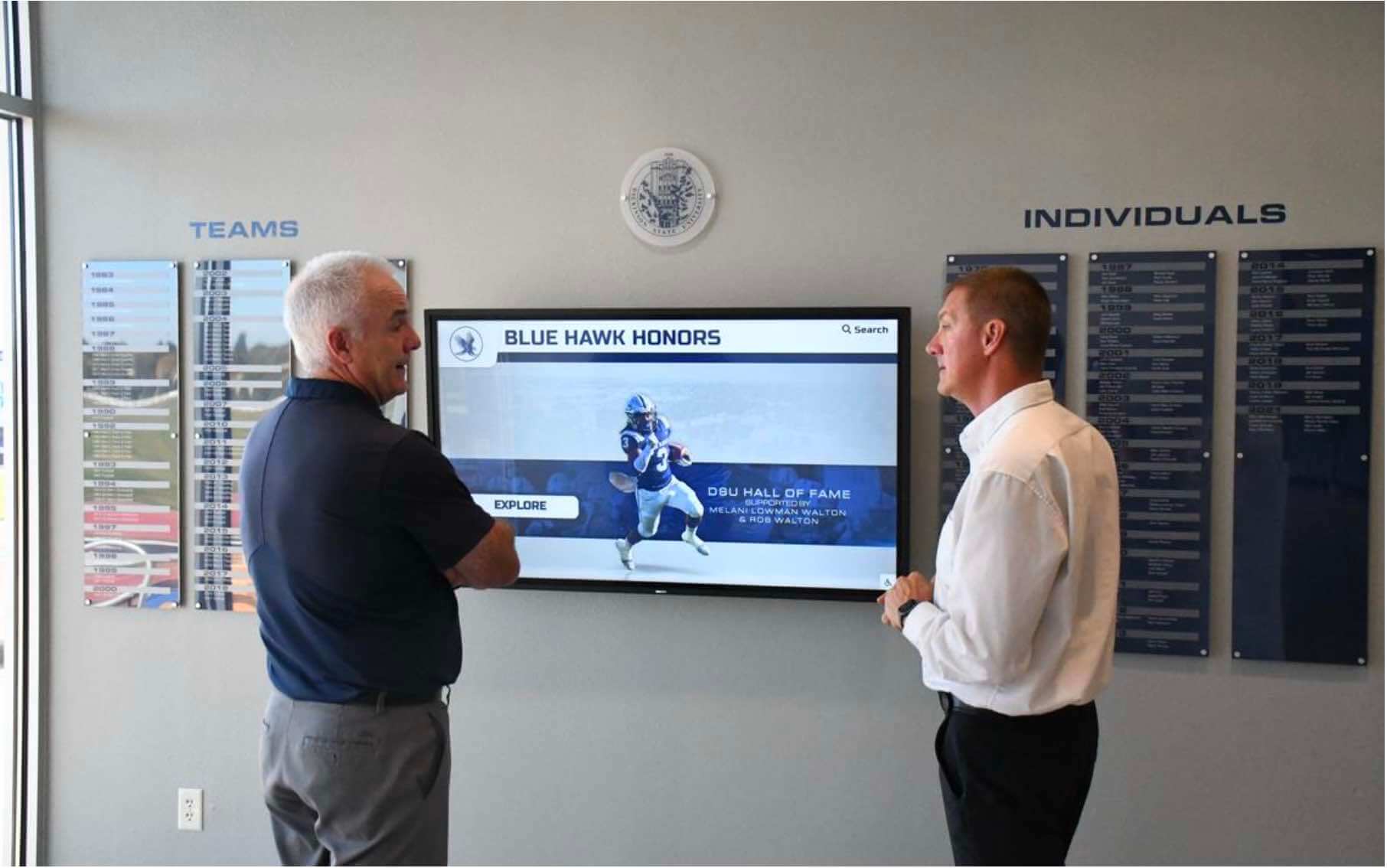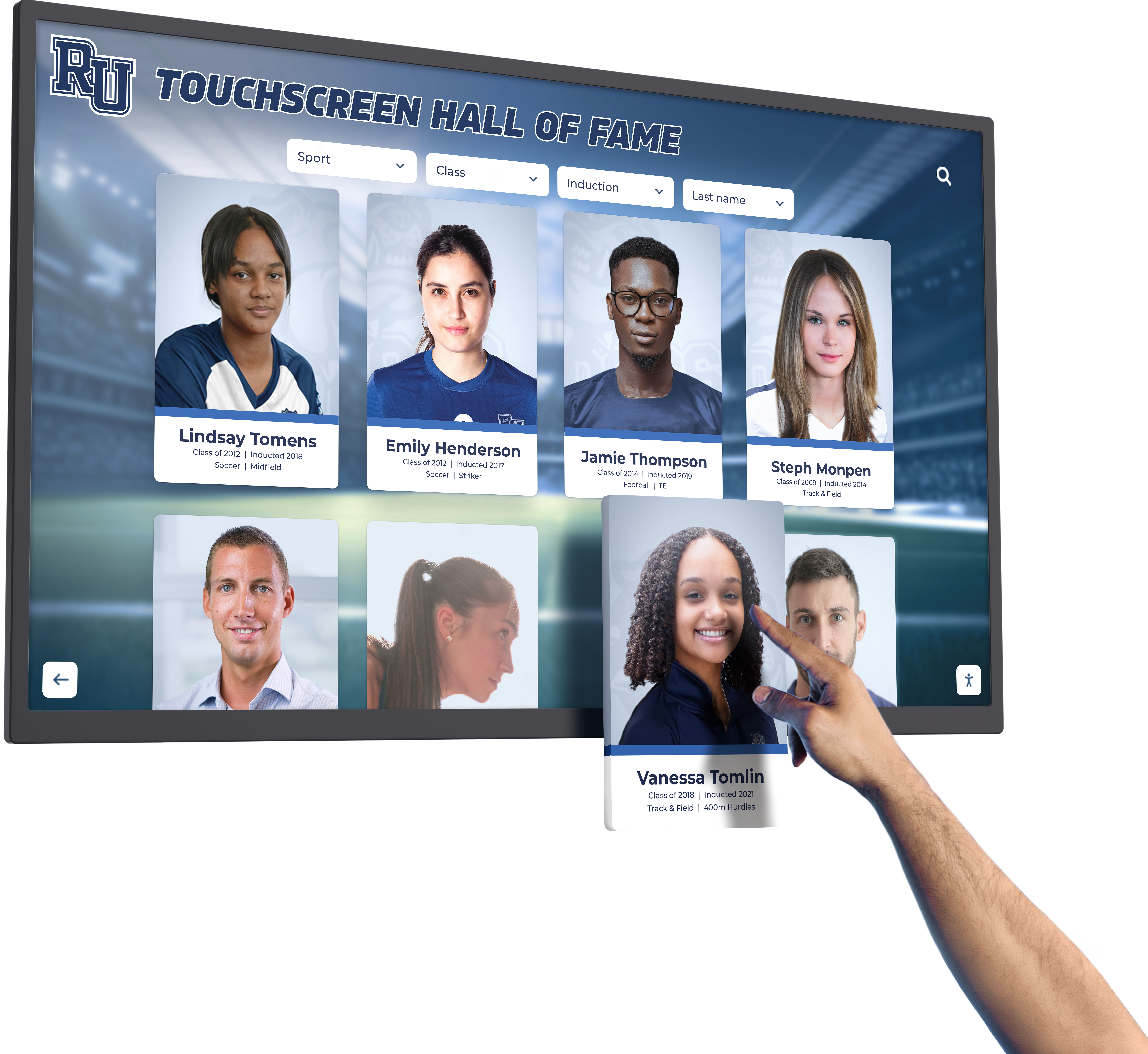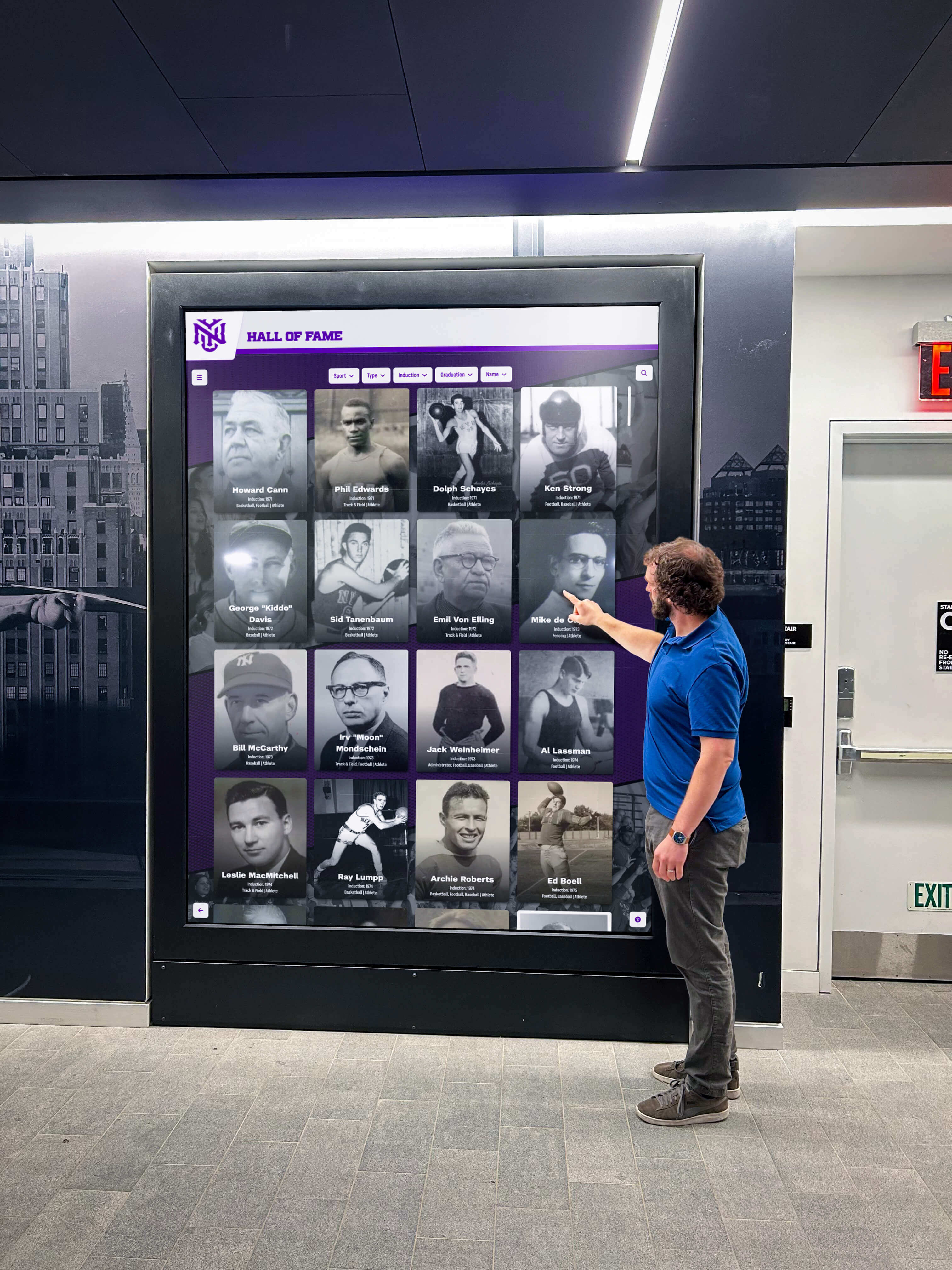The education technology landscape is experiencing a seismic shift. According to recent industry analysis, the AI education market is projected to grow from $7.57 billion in 2025 to $112.30 billion by 2034, representing a fundamental transformation in how educational institutions operate. While much attention focuses on AI in classrooms and learning management systems, a quieter revolution is reshaping how schools recognize, celebrate, and engage students through intelligent recognition technology.
Traditional recognition programs—static plaques, unchanging trophy cases, and standardized displays—served schools well for generations. However, these approaches treated all viewers identically, displayed the same content regardless of context, and required manual updates that often lagged behind actual achievements. Modern students, raised in environments where technology adapts to their preferences and delivers personalized experiences, increasingly find traditional recognition disconnected from their expectations.
This comprehensive guide explores how artificial intelligence and personalization technologies are transforming school recognition programs in 2025, examining practical applications, implementation strategies, and the future trajectory of this emerging field. Whether you’re an advancement director evaluating technology investments, a principal planning a recognition upgrade, or an IT administrator researching emerging educational technology, understanding AI-powered recognition’s capabilities and limitations will inform better decisions about your institution’s recognition future.
Understanding AI in Educational Recognition Technology
Before exploring specific applications, establishing clarity about what AI means in recognition contexts prevents confusion and manages expectations appropriately.
What AI Actually Means for Recognition Systems
The term “artificial intelligence” encompasses diverse technologies with varying sophistication levels and practical applications. In educational recognition contexts, AI typically refers to specific capabilities rather than human-like general intelligence.
Machine Learning for Content Recommendation: Machine learning algorithms analyze user interaction patterns to understand which content engages different audience segments. When a prospective student family explores athletic achievements while an alumnus focuses on academic profiles, the system learns these preference patterns and can adapt future content presentation accordingly.
Computer Vision for Photo Analysis: AI-powered computer vision can analyze uploaded photos to automatically identify appropriate content categories, detect whether images meet quality standards, and even recognize individuals when integrated with appropriate permission systems. This automation dramatically reduces manual photo tagging and organization workload that traditionally consumed significant staff time.
Natural Language Processing for Search: Rather than requiring users to know exact names or browse through structured categories, natural language processing enables intuitive search where visitors can ask questions like “show me chemistry teachers from the 1990s” or “find football players who went on to play professionally” and receive relevant results.

Predictive Analytics for Recognition Opportunities: By analyzing historical recognition patterns, demographic data, and participation metrics, AI can identify students or groups at risk of being overlooked in recognition programs. This predictive capability helps schools proactively ensure equitable recognition distribution rather than discovering gaps after the fact.
Adaptive Content Presentation: Intelligent systems can adjust what content appears, in what order, and with what emphasis based on time of day, viewer demographics (when known through login systems), recent institutional events, or other contextual factors. A display might emphasize different content during campus tours versus alumni reunions versus student passing periods.
Current State of AI Recognition Technology (2025)
The recognition technology landscape in 2025 reflects significant maturation beyond early experimental implementations, with several capabilities now commercially available and proven in educational environments.
Commercially Available Capabilities: Multiple vendors, including solutions like Rocket Alumni Solutions, now offer recognition platforms with integrated AI features that schools can deploy without requiring internal AI expertise. These production-ready systems handle photo organization, basic content recommendations, intelligent search, and adaptive displays through user-friendly interfaces that advancement and marketing staff manage without technical backgrounds.
Implementation Maturity: According to survey data from EDUCAUSE, 57% of higher education institutions prioritized AI in 2025, up from 49% the previous year, indicating growing institutional commitment beyond pilot projects to operational deployment. This maturity means schools can learn from early implementers’ experiences rather than pioneering entirely uncharted territory.
Practical vs. Theoretical Applications: While futuristic visions of fully autonomous recognition systems remain theoretical, practical applications delivering measurable value operate in schools today. The focus in 2025 centers on augmenting human decision-making and reducing administrative burden rather than replacing human judgment in recognition decisions—a pragmatic approach that schools find more acceptable and implementable.
Personalization: Making Recognition Relevant to Every Viewer
Beyond artificial intelligence’s technical capabilities, personalization represents the strategic application of technology to create more meaningful recognition experiences for diverse audiences with different interests and connections to institutions.
Why Generic Recognition Falls Short
Traditional recognition approaches displayed identical content to every viewer regardless of their relationship to the institution, interests, or reasons for engaging with recognition systems. This one-size-fits-all approach created several problems that personalization addresses.
A prospective student athlete visiting campus wants to see athletic history and records from their sport, understand pathways from high school athletics to college competition, and learn about alumni who achieved post-college athletic success. That same student cares less about academic achievements in subjects outside their interest areas or recognition categories unrelated to their potential student experience.
Meanwhile, an alumnus returning for their 30th reunion seeks connections to their era, wants to see classmates’ post-graduation accomplishments, and feels nostalgic about their own school experience. They engage differently with recognition content than current students do, seeking personal connection and historical context rather than future possibility.

Donors considering major gifts care about institutional impact, want evidence that contributions create lasting legacies, and seek understanding of how recognition honors their support. They need different content emphasis and presentation compared to casual visitors or current students.
Generic recognition that treats these diverse audiences identically delivers sub-optimal experiences for everyone, failing to maximize engagement or serve any audience particularly well.
Implementing Audience-Aware Recognition
Modern recognition platforms can adapt content presentation based on viewer context, creating more relevant experiences without requiring extensive manual content duplication.
Context Detection Methods: Systems can infer or directly determine viewer context through multiple approaches. Time-based context offers the simplest implementation—displays might emphasize different content during campus tours versus evening community events versus weekday class changes when primarily students pass by.
Login-based personalization, commonly used in alumni directories and online recognition portals, enables explicit personalization based on known user identities and preferences. When alumni access web-based recognition through accounts, systems can prioritize content from their graduation era, highlight classmates’ achievements, and suggest connections to users with similar interests or career paths.
Role-based content presentation adapts displays for different institutional areas. Recognition displays in athletic facilities might emphasize sports achievements while maintaining full content access through search, while displays in academic buildings foreground scholarly accomplishments without excluding other recognition categories.
Behavioral adaptation learns from interaction patterns. When visitors consistently search for specific content types or spend more time exploring certain categories, intelligent systems can adapt subsequent content recommendations and feature placement based on observed preferences.
Privacy and Ethical Considerations: Personalization that relies on identifying specific individuals raises legitimate privacy concerns that schools must address thoughtfully. Best practices include transparent communication about what data systems collect and how personalization works, opt-out provisions for individuals uncomfortable with personalized experiences, and strict limitations on using personalization for commercial purposes or in ways inconsistent with educational missions.
Many effective personalization approaches require no personal data collection—context-based adaptation using time, location, and general audience type creates relevant experiences without privacy implications.
Adaptive Content Recommendations
Beyond basic context awareness, sophisticated recognition systems can recommend specific content likely to interest individual viewers based on their exploration patterns and explicit interests.
Recommendation Algorithm Approaches: Collaborative filtering, borrowed from consumer applications, identifies patterns where viewers interested in certain content often also engage with other specific content. If visitors who explore 1980s football championships frequently also view engineering alumni profiles, the system can suggest engineering content to other football history enthusiasts.

Content similarity recommendations suggest related recognition based on shared attributes. Viewers exploring a particular alumnus might see recommendations for classmates, others from similar geographic regions, or individuals with related career paths.
Trending and social proof indicators highlight content attracting current attention, helping visitors discover popular recognition that others find interesting while enabling institutional communicators to understand what resonates with audiences.
Balancing Discovery and Focus: Effective personalization balances showing users content matching their expressed interests while maintaining discovery opportunities that expose them to achievements and stories they didn’t know to seek. Over-personalization that only shows expected content reduces serendipitous discovery that often creates memorable recognition experiences.
Practical AI Applications in School Recognition
Moving from conceptual understanding to concrete implementation, several specific AI applications deliver measurable value in educational recognition programs today.
Intelligent Photo Management and Organization
Photography represents both a crucial recognition component and a significant administrative challenge. Schools generate thousands of photos annually, yet organizing, tagging, and making these assets searchable traditionally required extensive manual labor.
Automated Photo Categorization: Computer vision AI can analyze photos to automatically identify appropriate categories, detect whether images show individuals or groups, recognize indoor versus outdoor settings, and even identify specific locations when trained on institutional spaces. This automation transforms photo upload from labor-intensive manual categorization to bulk upload with automated organization.
Quality Assessment: AI-powered quality analysis can flag photos with technical issues—insufficient resolution for large displays, poor lighting, excessive blur, or composition problems—before they enter recognition systems. This automatic quality gate ensures only appropriate images appear in public displays without requiring manual review of every submitted photo.
Facial Recognition for Access Control: While controversial in some applications, facial recognition serves legitimate purposes in recognition contexts when implemented with appropriate permissions and safeguards. Systems can identify whether uploaded photos include individuals with photo permissions on file, alert staff to permission issues before publication, and enable powerful search capabilities where users can find all recognition content featuring specific individuals.
Importantly, ethical facial recognition implementation requires explicit opt-in consent, transparent communication about system capabilities, and robust security protecting biometric data. Schools must balance technical capability against privacy rights and community comfort levels.
Content Rights Management: AI can track which photos have appropriate usage permissions, identify when permissions expire, and flag content requiring permission renewal. This automated rights management prevents compliance issues while reducing administrative workload compared to manual permission tracking.
Natural Language Search and Discovery
Traditional recognition system search required knowing exact names, selecting from predefined categories, or browsing chronologically. Natural language processing transforms search into conversational interaction matching how people think about information.
Conversational Search Examples: Rather than structured queries, visitors can use natural phrasing: “show me women in STEM careers,” “find alumni who became teachers,” “athletes who earned academic honors,” or “students from California.” The system parses intent, understands entity relationships, and returns relevant results without requiring users to master specific search syntax.
Synonym and Concept Understanding: Natural language systems understand that “gridiron” refers to football, “hoops” means basketball, and “graduating class” connects to specific years. This flexibility accommodates how people actually speak rather than forcing rigid terminology compliance.
Question Answering Capabilities: Advanced natural language systems can answer specific questions: “how many students earned National Merit recognition in 2020?” or “who holds the school record for long jump?” by understanding the question structure, identifying relevant recognition data, and formulating appropriate responses.
Predictive Analytics for Equitable Recognition
Perhaps the most impactful AI application involves using data analysis to ensure recognition programs serve all students rather than inadvertently concentrating acknowledgment among already-privileged groups.
Pattern Detection: Machine learning algorithms can analyze historical recognition data to identify concerning patterns invisible in casual observation. If recognition consistently underrepresents certain demographics, academic programs, or student populations, predictive systems flag these inequities for human review and intervention.
A study tracking student recognition programs might reveal that while English Language Learners comprise 15% of student population, they receive only 3% of recognition—a disparity that predictive analytics would highlight for administrators to address.
Proactive Opportunity Identification: Rather than waiting for staff to nominate every deserving student, AI can analyze participation data, grade patterns, and involvement records to suggest students who might warrant recognition consideration. When a student demonstrates significant improvement, achieves meaningful milestones, or contributes in ways that might escape notice, the system can generate recognition suggestions for human review.

Equity Auditing: Automated equity auditing compares recognition distribution against demographic composition, participation patterns, and other relevant metrics to generate reports showing where recognition aligns with or diverges from equitable distribution. These reports inform continuous improvement without requiring manual data analysis that most schools lack capacity to perform regularly.
Dynamic Content Scheduling and Freshness
Stale content undermines recognition program engagement. AI-powered scheduling ensures appropriate content rotation and timely updates that keep recognition systems feeling current and relevant.
Automated Content Rotation: Rather than displaying identical content indefinitely, intelligent systems can rotate featured recognition based on configurable rules. Recent achievements might receive temporary prominence before rotating to archival status, seasonal content (fall sports in autumn, spring sports in spring) can automatically adjust based on calendar, and anniversary recognition (50th reunion class, 25-year anniversary of championship) can appear during relevant time periods without manual scheduling.
Staleness Detection: AI can identify when displays haven’t received updates recently, when featured content has appeared unchanged for too long, or when recognition doesn’t reflect recent institutional events. Automated alerts prompt content managers to add fresh material, maintaining system vitality without requiring constant manual monitoring.
Event-Responsive Content: Integration with institutional calendars and event management systems enables recognition displays to automatically adapt around special events. During homecoming week, alumni content receives enhanced prominence. On athletic competition days, relevant sport recognition features more prominently. After academic honors ceremonies, newly recognized students appear in featured positions.
Implementation Strategies for AI-Powered Recognition
Understanding AI capabilities means little without practical implementation strategies that translate theoretical benefits into operational reality at your institution.
Assessing Institutional Readiness
Not every school needs or can effectively implement every AI capability. Thoughtful assessment of institutional context, needs, and capacity informs appropriate technology adoption.
Organizational Readiness Factors: Staff comfort with technology significantly affects implementation success. Institutions with staff who readily adopt new tools and feel comfortable troubleshooting minor issues implement AI-powered systems more smoothly than those where technology adoption requires extensive support and training.
Data quality and organization prerequisites determine AI effectiveness. Machine learning requires substantial training data—if your institution has sparse historical recognition content or poorly organized existing recognition, AI features may underperform until you build more comprehensive content libraries.
Recognition program maturity matters. Schools with well-established recognition programs, clear processes, and regular content updates gain more immediate value from AI optimization compared to institutions still building basic recognition infrastructure.
Needs Assessment: Before implementing AI features, identify specific problems AI might address. Do staff struggle with photo organization? Does manual recognition distribution analysis consume excessive time? Do visitors frequently complain about difficulty finding relevant content? Matching AI capabilities to real institutional challenges ensures technology investments solve actual problems rather than implementing technology for its own sake.
Phased Implementation Approach
Rather than attempting comprehensive AI deployment immediately, successful implementations typically follow staged approaches that build capability progressively while managing organizational change.
Phase 1: Foundation (Months 1-3) Begin with basic digital recognition infrastructure supporting future AI enhancement. Focus on content management systems, display hardware, and processes for regular recognition updates. Build substantial content libraries that AI features will later optimize.
Establish baseline metrics measuring current recognition program effectiveness—how many students receive recognition annually, time required for content updates, user engagement patterns, and equity distribution across demographics. These baselines enable measuring AI impact later.
Phase 2: Initial AI Features (Months 4-6) Introduce entry-level AI capabilities that deliver value without requiring extensive configuration or training. Automated photo categorization, basic content recommendations, and natural language search represent accessible starting points that staff quickly appreciate and that demonstrably reduce workload.
Select recognition technology partners with proven educational experience and robust support models who can guide implementation rather than leaving institutions to navigate challenges independently.
Phase 3: Advanced Personalization (Months 7-12) Once basic AI features operate smoothly and staff feel comfortable with intelligent systems, expand to more sophisticated capabilities. Implement adaptive content presentation, deploy predictive equity analytics, and enable more complex personalization features that require configuration and ongoing optimization.
Phase 4: Continuous Optimization (Ongoing) Treat AI implementation as ongoing process rather than finite project. Regularly review system performance data, gather user feedback, adjust algorithms based on institutional priorities, and incorporate new capabilities as technology evolves.
Training Staff for AI-Augmented Recognition
Technology succeeds only when people use it effectively. Comprehensive training ensures staff understand both AI capabilities and appropriate ways to leverage intelligent systems.
Conceptual Understanding: Staff need basic comprehension of how AI works, what it can and cannot do, and why certain capabilities require particular approaches. This conceptual foundation prevents unrealistic expectations while building confidence that staff can manage AI-powered systems without technical expertise.
Practical Skills Training: Hands-on training covering common tasks—uploading and categorizing content, reviewing AI-generated recommendations, adjusting personalization settings, and interpreting analytics reports—builds competence and comfort. Training should emphasize that AI augments rather than replaces human judgment, with staff retaining authority over recognition decisions.
Ethical Considerations: Staff managing AI-powered recognition need training on privacy implications, equity considerations, and ethical usage. Understanding when human review is required, how to identify algorithmic bias, and what practices ensure appropriate AI usage prevents well-intentioned staff from inadvertently misusing powerful technology.
The Future of AI in Educational Recognition
While 2025 represents significant advancement in AI-powered recognition, the trajectory suggests even more transformative capabilities emerging in coming years.
Emerging Capabilities on the Horizon
Generative AI for Content Creation: Large language models can already draft compelling text, and their integration into recognition systems will enable automatic generation of achievement descriptions, biographical summaries, and recognition narratives from structured data inputs. Rather than manually writing each profile, staff might review and refine AI-generated drafts, dramatically accelerating content production.
Natural language generation could produce multiple versions of recognition content optimized for different audiences—shorter summaries for quick display rotation, detailed profiles for deep exploration, and compelling narratives for advancement materials—from single data sources.
Voice Interaction and Accessibility: Voice-enabled recognition systems where visitors can verbally ask questions and receive spoken responses will make recognition accessible to visually impaired users while enabling hands-free exploration. These conversational interfaces lower interaction barriers and create more inclusive recognition experiences.

Emotion Detection and Response: While controversial, emotion recognition technology that detects viewer facial expressions could enable systems to gauge content resonance and adapt presentation accordingly. If visitors consistently smile when viewing certain content types or appear confused by specific information, systems could adjust emphasis and presentation.
Ethical implementation of emotion detection requires careful consideration of privacy implications and consent requirements, with many schools likely to forgo these capabilities even as they become technically feasible.
Augmented Reality Integration: Mobile augmented reality applications could overlay digital recognition content on physical spaces. Pointing smartphones at locations might reveal historical photos, achievement information, or multimedia content enhancing physical recognition displays with digital augmentation that updates easily and provides unlimited information depth.
Predictive Personalization: Rather than reacting to demonstrated preferences, future systems might predict interests and preferences based on demographic data, role information, or similar users’ patterns. A newly admitted student might immediately experience personalized recognition emphasizing content relevant to their intended major, activities, and geographic background without first establishing individual preference history.
Balancing Innovation with Purpose
Amid enthusiasm for technological capability, educational institutions must maintain focus on recognition’s fundamental purposes—honoring achievement, inspiring current students, strengthening community connections, and celebrating excellence.
Technology as Means, Not End: AI and personalization technologies serve recognition objectives; they don’t constitute objectives themselves. The question isn’t “how can we use AI in recognition?” but rather “how can AI help us recognize students more effectively, equitably, and meaningfully?” This purpose-driven approach ensures technology adoption genuinely serves institutional missions.
Human Elements Remain Central: The most sophisticated AI cannot replicate human understanding of achievement significance, cultural sensitivity about appropriate recognition, or nuanced judgment about handling complex situations. Recognition programs must preserve human decision-making authority while leveraging AI for tasks machines perform well—data analysis, pattern recognition, and repetitive processing.
Equity as Non-Negotiable Priority: As AI capabilities expand, ensuring technology advances rather than undermines equity must remain paramount. Algorithms can perpetuate or amplify bias present in training data. Personalization can inadvertently create filter bubbles limiting exposure to diverse achievements. Schools must actively monitor AI systems for equity impacts and intervene when technology produces inequitable outcomes.
Real-World Implementation Considerations
Moving from vision to reality requires addressing practical challenges that institutions encounter when deploying AI-powered recognition systems.
Budget and Resource Planning
AI-capable recognition systems typically require larger initial investments than traditional approaches, though operational efficiencies often generate favorable long-term cost equations.
Technology Investment Components: Hardware supporting AI features—higher-resolution displays enabling quality photo presentation, adequate processing power for machine learning, and network infrastructure supporting cloud-based AI services—may exceed basic recognition display costs. Cloud-based platforms can reduce upfront hardware costs by leveraging provider infrastructure, though subscription models create ongoing expenses.
Professional implementation services ensure successful deployment. Most schools benefit from expert assistance with initial configuration, staff training, and system optimization rather than attempting fully independent implementation.
Operating Cost Considerations: Subscription fees for AI-powered platforms typically exceed perpetual licensing costs for basic systems, though subscription models often include automatic updates, ongoing support, and continuous feature enhancements that perpetual licenses lack.
Reduced staff time requirements for content management, photo organization, and recognition distribution analysis often offset subscription costs through operational efficiency gains. When advancement staff spend hours weekly on tasks that AI automation completes in minutes, the technology investment generates clear ROI through capacity reallocation to higher-value activities.
Privacy and Data Governance
AI-powered recognition systems collect, analyze, and utilize data in ways traditional recognition never did, creating governance responsibilities schools must address explicitly.
Data Collection Transparency: Clear communication about what information recognition systems collect, how AI uses that data, and what privacy protections exist builds community trust and meets ethical obligations. Privacy policies should explicitly address AI usage rather than assuming general institutional policies cover novel technology applications.
Consent Management: Robust consent systems enable individuals to opt out of AI-powered features like facial recognition or personalized recommendations while still appearing in recognition content. Granular consent options respect varying comfort levels with AI applications.
Security Requirements: AI systems processing recognition data require appropriate security protecting against unauthorized access, data breaches, or misuse. Cloud-based systems should meet education-specific security standards like those outlined in data privacy and security compliance guides for educational technology.
Vendor Selection and Partnership
Few schools possess internal expertise to build AI recognition systems from scratch, making vendor selection crucial to implementation success.
Evaluation Criteria: Educational experience matters significantly. Vendors with proven track records serving K-12 schools, universities, and educational institutions understand regulatory environments, typical workflows, and community expectations that generic technology providers lack.
AI capability transparency distinguishes genuine AI implementation from marketing hyperbole. Vendors should clearly explain what specific AI technologies their systems employ, what capabilities are production-ready versus roadmap promises, and what realistic performance expectations are.
Support models determine long-term success. Comprehensive training, responsive technical support, and ongoing consultation ensure schools successfully implement and optimize AI features rather than struggling with under-utilized technology.
Platform evolution commitment indicates whether vendors will continue advancing AI capabilities or whether current features represent static offerings unlikely to improve. Questions about research and development investment, feature roadmaps, and upgrade paths reveal vendor commitment to ongoing innovation.

Solutions like Rocket Alumni Solutions provide purpose-built platforms specifically designed for educational recognition with integrated AI capabilities, proven implementation methodologies, and dedicated focus on helping schools celebrate student achievement effectively while continuously advancing platform capabilities as AI technology evolves.
Measuring AI Recognition Program Success
Implementing AI-powered recognition without systematic assessment means missing opportunities for optimization and lacking evidence demonstrating value to institutional stakeholders.
Quantitative Performance Indicators
Efficiency Metrics: Time required for common administrative tasks—uploading and organizing photos, creating recognition profiles, updating display content—before and after AI implementation quantifies efficiency gains. Many institutions report 60-70% reductions in content management time following AI automation deployment.
User engagement metrics including touchscreen interaction frequency, session duration, content searches performed, and return visitor rates indicate whether AI-powered personalization increases engagement compared to static recognition approaches.
Recognition distribution equality measured across demographics, programs, and student populations demonstrates whether predictive analytics effectively promote equitable recognition or whether traditional disparities persist despite AI assistance.
Qualitative Impact Assessment: Stakeholder surveys gathering feedback from students, alumni, families, and staff about recognition program quality, perceived fairness, content relevance, and overall satisfaction provide crucial qualitative complement to quantitative metrics.
Staff interviews exploring how AI affects recognition program management, whether technology creates new challenges alongside efficiency gains, and what additional AI capabilities would provide value inform continuous improvement.
Anecdotal impact stories capturing specific instances where personalized recognition created meaningful experiences or where predictive analytics identified overlooked students provide compelling evidence of AI value beyond statistics.
Continuous Improvement Processes
Regular Algorithm Auditing: Periodic review of AI system outputs ensures algorithms perform as intended without developing problematic biases or degrading accuracy over time. Equity audits specifically examining whether AI systems produce equitable outcomes across demographics catch issues before they create significant disparities.
User Feedback Integration: Systematic collection and analysis of user feedback about AI features—what personalization approaches work well, which intelligent systems cause confusion, what capabilities users wish existed—drives iterative enhancement ensuring technology evolution aligns with actual user needs.
Performance Benchmarking: Comparing your implementation’s performance against institutional goals, peer institutions, and industry benchmarks reveals whether your AI-powered recognition achieves expected results or underperforms in ways requiring intervention.
Preparing for AI-Powered Recognition: Actionable Next Steps
For institutions ready to explore AI and personalization in recognition programs, systematic preparation maximizes implementation success likelihood.
Step 1: Conduct Recognition Program Assessment
Begin by evaluating your current recognition program’s strengths, weaknesses, and improvement priorities. Identify specific challenges that AI capabilities might address—administrative inefficiency, stale content, inequitable recognition distribution, poor user engagement, or difficulty managing growing recognition content volumes.
Document baseline metrics measuring current program performance so AI implementation impact can be quantified later. Gather stakeholder feedback about recognition program satisfaction and improvement priorities to ensure technology investments address real needs rather than assumed problems.
Step 2: Build AI Literacy Among Stakeholders
Invest in education helping administrators, advancement staff, and other stakeholders understand AI capabilities, limitations, and appropriate applications. This shared understanding prevents unrealistic expectations while building enthusiasm for strategic AI adoption.
Address concerns and questions about AI early in the process. Privacy implications, job security fears, and skepticism about technology effectiveness create resistance when left unaddressed but can be managed through transparent communication and thoughtful implementation approaches.
Step 3: Research Available Solutions
Survey the recognition technology landscape, focusing on providers with demonstrated educational experience and proven AI implementations. Request demonstrations showing actual AI capabilities rather than accepting marketing claims, and speak with reference institutions about their implementation experiences, lessons learned, and satisfaction with AI features.
Explore emerging trends in digital recognition to understand both current capabilities and likely near-term developments that might inform technology selection.
Step 4: Develop Implementation Roadmap
Create a phased plan that staggers AI capability deployment, allowing organizational learning and adjustment between implementation phases. Start with high-value, low-complexity AI features that demonstrate benefits quickly, then expand to more sophisticated capabilities as staff competence and organizational comfort grow.
Identify required resources including budget, staff time, technical infrastructure, and training needed at each phase. Realistic resource planning prevents project stalls when unexpected requirements emerge.
Step 5: Establish Governance and Ethical Guidelines
Develop clear policies governing AI usage in recognition contexts before implementation begins. Address data collection, privacy protection, consent management, algorithmic bias prevention, and ethical boundaries ensuring AI serves rather than subverts institutional values.
Form a diverse oversight committee that monitors AI recognition systems for equity impacts, reviews algorithmic decisions for appropriateness, and ensures ongoing alignment between technology capabilities and institutional missions.
Conclusion: Embracing Intelligent Recognition’s Potential While Honoring Timeless Values
The transformation AI and personalization bring to educational recognition represents genuine advancement enabling schools to honor achievement more effectively, equitably, and meaningfully than traditional approaches allowed. Automated content management that liberates staff from repetitive tasks, predictive analytics identifying recognition inequities invisible to human observation, and personalized experiences that connect individuals with recognition content relevant to their interests and relationships—these capabilities solve real problems that limited recognition program effectiveness for generations.
Yet amidst enthusiasm for technological capability, educational institutions must maintain unwavering focus on recognition’s enduring purposes. Technology serves human goals; it doesn’t supplant them. The question confronting schools isn’t whether AI offers valuable capabilities—clearly it does—but rather how to thoughtfully integrate those capabilities in ways that amplify rather than diminish recognition’s human elements.
The most successful AI-powered recognition implementations will balance technological sophistication with organizational readiness, innovative features with intuitive usability, automated efficiency with human judgment, and personalized experiences with equitable access. Schools that view AI as tool serving institutional mission rather than end in itself will deploy these powerful technologies most effectively.
As you consider AI-powered recognition for your institution, remember that the technology exists to help you achieve recognition’s timeless objectives—celebrating excellence, inspiring aspiration, strengthening community, and honoring achievement. When technology adoption serves those purposes while respecting human dignity, privacy, and equity, AI-powered recognition becomes not a replacement for traditional approaches but rather their fulfillment—finally enabling schools to recognize students as comprehensively, personally, and meaningfully as they deserve.
Ready to explore how AI-powered recognition could transform your institution’s ability to celebrate student achievement? Connect with experienced providers like Rocket Alumni Solutions who can guide thoughtful implementation that balances innovation with purpose, technology with humanity, and capability with institutional values.




































